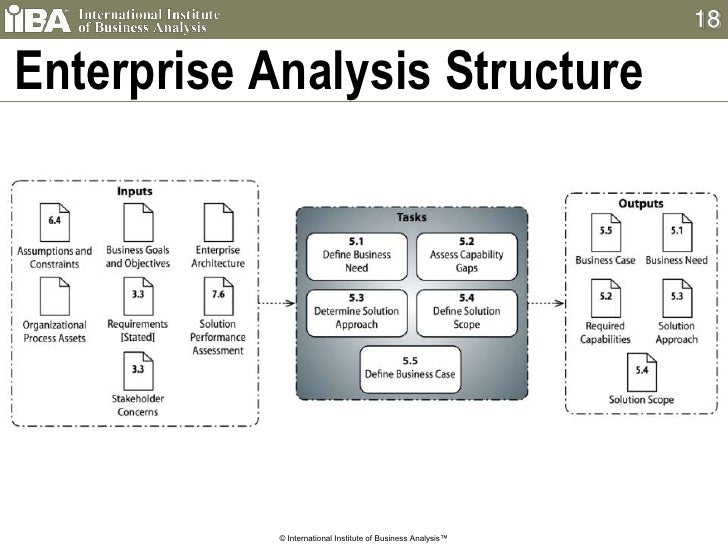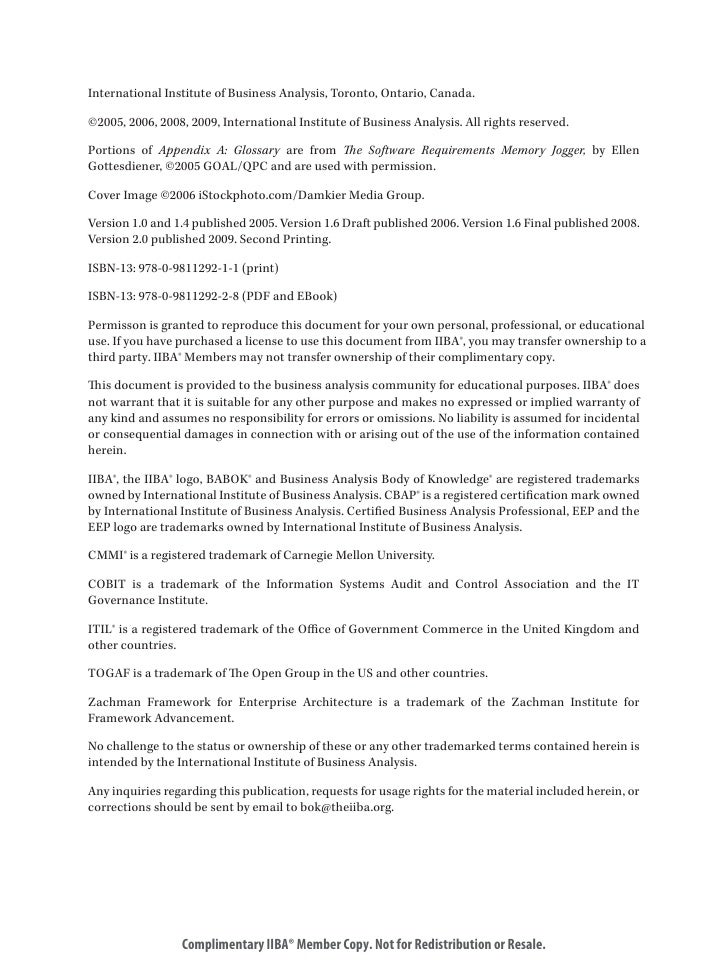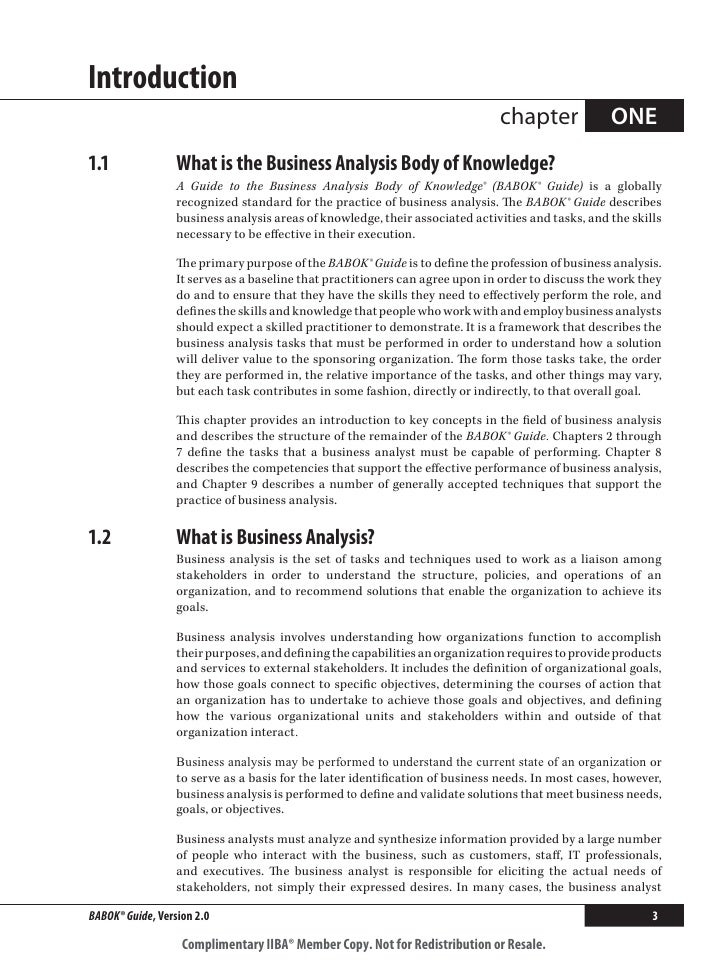Babok Guide Pdf Espanol
BABOK®3 Guide study guide mind map por 1. Business Analysis is the practice of enabling change in an organizational context, by defining needs and recommending solutions that deliver value to stakeholders.
The set of tasks and techniques that are used to perform business analysis are defined in A Guide to the Business Analysis Body of Knowledge® (BABOK®Guide). BABOK v1.6 was published in 2006 1.2. BABOK v2 was published in 2009 1.3. BABOK v3 was published in 2015 2. Knowledge Areas (6) 2.1. Business Analysis Planning and Monitoring (Chapter 3) 2.2. Elicitation and Collaboration (Chapter 4) 2.3.

Requirements Life Cycle Management (Chapter 5) 2.4. Strategy Analysis (Chapter 6) 2.5. Requirements Analysis and Design Definition (Chapter 7) 2.6. Solution Evaluation (Chapter 8) 2.7. Underlying Competencies (Chapter 9) 3.
Tasks (30) 3.1. Task characteristics 3.1.1. Has a purpose 3.1.2.
Has inputs 3.1.3. Is complete 3.1.4.
Uses techniques 3.1.5. Involves stakeholders 3.1.6. Has outputs / results 3.1.7. Tasks may be performed formally or informally. Tasks may be performed in any order. Tasks are grouped into Knowledge Areas (6) 3.2.1.
Best pc tv tuner software. Business Analysis Planning and Monitoring (Chapter 3) 3.2.1.1. 3.1 Plan Business Analysis Approach 3.2.1.2. 3.2 Plan Stakeholder Engagement 3.2.1.3.
3.3 Plan Business Analysis Information Management 3.2.1.4. 3.4 Plan Business Analysis Governance 3.2.1.5. 3.5 Identify Business Analysis Performance Improvements 3.2.2. Elicitation and Collaboration (Chapter 4) 3.2.2.1.
4.1 Prepare for Elicitation 3.2.2.2. 4.2 Conduct Elicitation 3.2.2.3. 4.3 Confirm Elicitation Results 3.2.2.4. 4.4 Communicate Business Analysis Information 3.2.2.5. 4.5 Manage Stakeholder Collaboration 3.2.3. Requirements Life Cycle Management (Chapter 5) 3.2.3.1.
5.1 Trace Requirements 3.2.3.2. 5.2 Maintain Requirements 3.2.3.3. 5.3 Prioritize Requirements 3.2.3.4.
5.4 Assess Requirements Changes 3.2.3.5. 5.5 Gain Consensus 3.2.4.
Strategy Analysis (Chapter 6) 3.2.4.1. 6.1 Analyze Current State 3.2.4.2. 6.2 Define Future State 3.2.4.3. 6.3 Assess Risks 3.2.4.4. 6.4 Define Change Strategy 3.2.5. Requirements Analysis and Design Definition (Chapter 7) 3.2.5.1. 7.1 Specify and Model Requirements 3.2.5.2.
7.2 Verify Requirements 3.2.5.3. 7.3 Validate Requirements 3.2.5.4. 7.4 Define Requirements Architecture 3.2.5.5. 7.5 Define Solution Options 3.2.5.6. 7.6 Analyze Potential Value and Recommend Solution 3.2.6.
Solution Evaluation (Chapter 8) 3.2.6.1. 8.1 Measure Solution Performance 3.2.6.2.
8.2 Analyze Performance Measures 3.2.6.3. 8.3 Assess Solution Limitations 3.2.6.4. 8.4 Assess Enterprise Limitations 3.2.6.5. 8.5 Recommend Actions to Increase Solution Value 4. What's new in the upcoming BABOK®3?, IIBA Austria Chapter Meeting 4.1. Underlying Competencies of Business Analyst (6) 5.1.
Analytical Thinking and Problem Solving 5.2. Behavioral Characteristics 5.3. Business Knowledge 5.4. Communication Skills 5.5. Interaction Skills 5.6. Software Applications 6. The Business Analysis Core Concept Model™ (BACCM™) 6.1.
The Business Analysis Core Concept Model™ (BACCM™) - Business Analysis Framework (a.k.a. The Turtle) 6.1.1. 6 core recurring concepts 6.1.2. Uniting a community of practitioners requires common terminology 6.2.
6 major questions (six Core Concepts) need to be answered (central questions in business analysis) 6.2.1. Change 6.2.1.1. What is the kind of change we're doing? A controlled transformation of the organization / enterprise. Need 6.2.2.1. What are the need we're trying to satisfy? A problem, opportunity, or constraint with potential value to a stakeholder.
Solution 6.2.3.1. What are the solutions we're trying to satisfy? A specific way of satisfying one or more needs in a context. Value 6.2.4.1. What do stakeholders consider to be of value? The worth, importance, or usefulness of something to a stakeholder within a context. Stakeholder 6.2.5.1.

Who are the stakeholders involved? A group or individual with a relationship to the change or the solution.
Context 6.2.6.1. What is the context in which we and the solution are in? The circumstances that form the setting for a change and allows for further understanding and assessment of the change. Perspectives (5) 7.1. Perspectives describe specialized disciplines within the practice of business analysis. A Perspective is a set of behaviours, terminology, and attitudes used by a business analyst within their specific type of business analysis work.
Perspectives have the following structure 7.2.1. Change Scope 7.2.2. Business Analysis Scope 7.2.3. Impact on Knowledge Areas 7.2.4.
Methodologies and Techniques 7.2.5. Underlying Competencies 7.3. Business Intelligence 7.5. Information Technology 7.6. Business Architecture 7.7.
Business Process Management 8. BABOK®3 consists of: 6 Knowledge Areas, 30 Tasks, 46 Techniques, 6 Underlying Competencies of Business Analyst, 1 Business Analysis Core Concept Model (BACCM), 5 Perspectives. Download BABOK®3 Knowledge Areas vs Techniques (PDF) 9.
Interactive BABOK®3 Glossary 9.1. Interactive BABOK®3 Glossary 10. Stakeholders 10.1. Business Analyst 10.2.
Change Control Board (CCB) 10.3. Customer 10.4. Domain Subject Matter Expert (SME) 10.5. End User 10.6. Implementation Subject Matter Expert (SME) - examples 10.6.1. Change Manager 10.6.2. Configuration Manager 10.6.3.

Database Administrator 10.6.4. Developer / Software Engineer 10.6.5. Information Architect 10.6.6. Organizational Change Management Professionals 10.6.7. Project Librarian 10.6.8. Solution Architect 10.6.9.
System Architect 10.6.10. Trainer 10.6.11. Usability Analyst 10.6.12. Usability Professional 10.7.
Operational Support 10.8. Project Manager 10.9. Regulator 10.10. Sponsor 10.11. Supplier 10.12. Techniques (46) 11.1. Acceptance and Evaluation Criteria Definition (10.1) 11.2.
Backlog Management (10.2) 11.3. Balanced Scorecard (10.3) 11.4.
Benchmarking and Market Analysis (10.4) 11.5. Brainstorming (10.5) 11.6.
Business Capability Analysis (10.6) 11.7. Business Model Canvas (10.7) 11.8. Business Rules Analysis (10.8) 11.9.
Collaborative Game (10.9) 11.10. Data Dictionary (10.10) 11.11. Data Flow Diagrams (10.11) 11.12. Data Modeling (10.12) 11.13. Decision Analysis (10.13) 11.14.
Decision Modeling (10.14) 11.15. Document Analysis (10.15) 11.16. Estimation (10.16) 11.17. Focus Groups (10.17) 11.18. Functional Decomposition (10.18) 11.19. Glossary (10.19) 11.20. Interface Analysis (10.20) 11.21.
Interviews (10.21) 11.22. Item Tracking (10.22) 11.23. Lessons Learned (10.23) 11.24. Metrics and Key Performance Indicators (KPIs) (10.24) 11.25.
Non-functional Requirements Analysis (10.25) 11.26. Observation (10.26) 11.27. Organization Modeling (10.27) 11.28. Priortization (10.28) 11.29. Process Analysis (10.29) 11.30. Process Modeling (10.30) 11.31. Prototyping (10.31) 11.32.
Reviews (10.32) 11.33. Risk Analysis and Management (10.33) 11.34. Roles and Permissions Matrix (10.34) 11.35. Root Cause Analysis (10.35) 11.36. Scenarios (10.36) 11.37.
Scope Modeling (10.37) 11.38. Sequence Diagrams (10.38) 11.39. Stakeholder List, Map, or Personas (10.39) 11.40. State Modeling (10.40) 11.41. Survey or Questionnaire (9.41) 11.42. SWOT Analysis (10.42) 11.43. User Cases (10.43) 11.44.
User Stories (10.44) 11.45. Vendor Assessment (10.45) 11.46. Workshops (10.46) 12. Requirements Classification Schema 12.1. Business requirements 12.2.
Stakeholder requirements 12.3. Solution requirements 12.4. Transition requirements 13. This freeware, non-commercial mind map (aligned with the newest version of BABOK®) was carefully hand crafted with passion and love for learning and constant improvement as well for promotion the BABOK® and business analysis profession and as a learning tool for candidates wanting to gain CBAP® qualification.
(please share, like and give feedback - your feedback and comments are my main motivation for further elaboration. Questions / issues / errors? What do you think about my work?
Your comments are highly appreciated. Feel free to visit my website: www.miroslawdabrowski.com 13.1.1. Miroslawdabrowski 14. BABOK V3 Promotional Vide 14.1.
BABOK v3 Demystified 15.1.
Babok v2.0. 1. A Guide to the Business Analysis Body of Knowledge® (BABOK® Guide) Version 2.0 www.theiiba.orgComplimentary IIBA® Member Copy. Not for Redistribution or Resale. International Institute of Business Analysis, Toronto, Ontario, Canada.©2005, 2006, 2008, 2009, International Institute of Business Analysis. All rights reserved.Portions of Appendix A: Glossary are from The Software Requirements Memory Jogger, by EllenGottesdiener, ©2005 GOAL/QPC and are used with permission.Cover Image ©2006 iStockphoto.com/Damkier Media Group.Version 1.0 and 1.4 published 2005. Version 1.6 Draft published 2006.
Version 1.6 Final published 2008.Version 2.0 published 2009. Second Printing.ISBN-13: 978-0-9811292-1-1 (print)ISBN-13: 978-0-9811292-2-8 (PDF and EBook)Permisson is granted to reproduce this document for your own personal, professional, or educationaluse. If you have purchased a license to use this document from IIBA®, you may transfer ownership to athird party. IIBA® Members may not transfer ownership of their complimentary copy.This document is provided to the business analysis community for educational purposes. IIBA® doesnot warrant that it is suitable for any other purpose and makes no expressed or implied warranty ofany kind and assumes no responsibility for errors or omissions.
Babok Guide V3 Pdf Free
No liability is assumed for incidentalor consequential damages in connection with or arising out of the use of the information containedherein.IIBA®, the IIBA® logo, BABOK® and Business Analysis Body of Knowledge® are registered trademarksowned by International Institute of Business Analysis. CBAP® is a registered certification mark ownedby International Institute of Business Analysis.